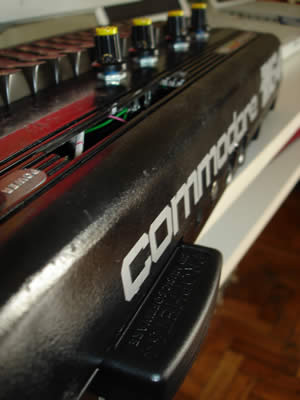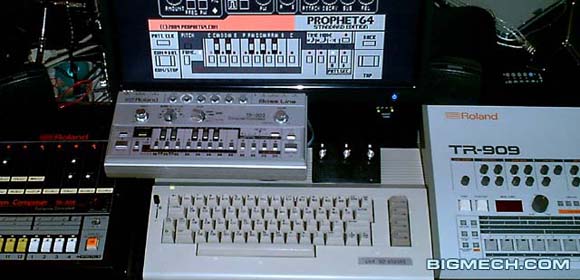 Thanks to the release of the Prophet 64 music production cartridge for Commodore 64, a lot of C64 music makers have been hanging out on the Prophet 64 Yahoo Group. There are some really talented hackers and case modifiers building beautiful custom computers out of vintage Commodore machines. Last week, we got to see Traktor DJ controllers and knob mods; here are some more:
Thanks to the release of the Prophet 64 music production cartridge for Commodore 64, a lot of C64 music makers have been hanging out on the Prophet 64 Yahoo Group. There are some really talented hackers and case modifiers building beautiful custom computers out of vintage Commodore machines. Last week, we got to see Traktor DJ controllers and knob mods; here are some more:
8GB has a gorgeous case mod for a C64 dubbed the M64. It has the onboard knobs we saw in the other modifications, plus a lovely black paint scheme, shown here. It’s also nice to see the C64 with the Prophet64 cart coexisting with more modern computers; this is truly an outboard hardware synthesizer for the computer age. (Once I get mine, I hope to do the same, though I kinda like the original Commodore beige. Good thing, too, because my building-and-painting skills leave a lot to be desired.)
 AlphA has performed extensive modifications to a C64c to make it easier to use with Prophet64 and easier to integrate into a studio. The I/O mods are the best part: would you believe a C64 with audio inputs and outputs, S-Video, and standard serial, sync, and power, all relocated for convenience? This isn’t just hacking for the sake of it; this is really building a usable, custom instrument that fits a musician’s needs. Check out this pounding track featuring the SID synth from the C64 along with Roland TB-303, TR-909, TR-808 and a quick SH-101 arpeggio. No glitchy oddness here: this is heavily-modded vintage gear you can dance to. If there’s a global cyber-apocalypse and the world winds up looking like something out of a Japanese manga, with people scavanging old computer and electronic hardware via underground markets, I think people will make music that sounds like this, dancing away the night inside their mech suits.
AlphA has performed extensive modifications to a C64c to make it easier to use with Prophet64 and easier to integrate into a studio. The I/O mods are the best part: would you believe a C64 with audio inputs and outputs, S-Video, and standard serial, sync, and power, all relocated for convenience? This isn’t just hacking for the sake of it; this is really building a usable, custom instrument that fits a musician’s needs. Check out this pounding track featuring the SID synth from the C64 along with Roland TB-303, TR-909, TR-808 and a quick SH-101 arpeggio. No glitchy oddness here: this is heavily-modded vintage gear you can dance to. If there’s a global cyber-apocalypse and the world winds up looking like something out of a Japanese manga, with people scavanging old computer and electronic hardware via underground markets, I think people will make music that sounds like this, dancing away the night inside their mech suits.
Check out the Roland gear here. Now you know who sniped you on those eBay auctions:

Back to reality — if you notice how clean the SID sounds in the mix, it’s because this is the later revision of the SID chip as included on the C64c, without the design defects that causes the earlier SID’s glitchy sound. Each chip has its following — the later is the synth as intended, whereas the earlier synth has a personality all its own because of its defects. Wikipedia explains it better than I do, because I’m still high on Benadryl as I try to get over a virus. (See, you knew there was a reason my recent posts have been a little scattered.)
For overwhelming evidence that we’re not worthy of AlphA’s graphical and hardware-modding skills, take a look at the rest of the site and be humbled. (At least, that’s how it worked out for me. I think this person is indeed living in a manga.)